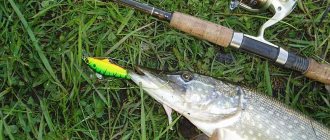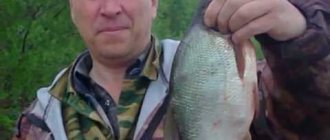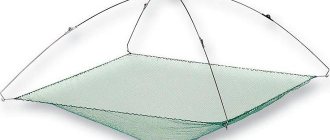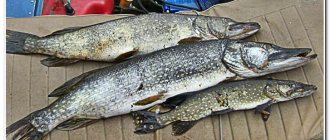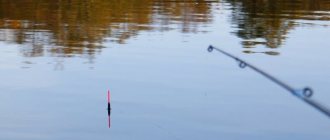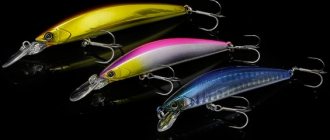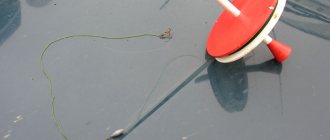Some rivers have a fairly strong current, which becomes especially noticeable during the spring rise in water levels. Often in such a situation, even the use of extra heavy class feeders and the heaviest feeders is not enough for successful fishing. In such situations, the running donka helps out. This gear allows you to quite successfully catch both peaceful and predatory fish even in the strongest currents, since this method does not imply that the equipment is constantly located at one point. Instead, hooks with a nozzle lead at a faster or slower pace, depending on what specific type of fish is being hunted - if the object being fished is a predator like perch, then the wiring resembles a spinning jig; for white fish, slower options are used , however, in both cases the flow directly affects the game.
The main differences from feeder fishing
Fishing with a running donkey differs from a feeder primarily in the rods used, equipment and tactics.
Rods for this method of fishing are rarely purchased specially (unlike the same feeder, where normal fishing can only be done with special rods that have appropriate tips). Most often, the tools available to a particular angler are used - spinning rods with a sufficient test range or picker rods. Long forms (more than 3 meters) are practically not used.
The equipment itself is also different. For a running bottom, it is usually not a feeder that is used, but a regular sinker (at the same time, the use of weights made of different materials allows you to adapt to different fishing conditions). The equipment, unlike the classic feeder one, has not one leash with hooks, but several.
There is also a significant difference in tactics. Feeder involves selecting one or several fishing points (often these are various anomalies on the bottom such as edges or a section of shells) and feeding them abundantly. When fishing with a running bottom, there is usually a frequent change of fishing location, and feeding a point in conditions of strong current does not make much sense.
If the feeder uses mostly thin cords, then for such bottoms they usually use relatively thick monofilament lines, since there is no goal here to minimize the impact of the current; on the contrary, by putting pressure on the fishing line, it revives the play of the bait.
Tactics for fishing with a running donkey
Fishing with a running bottom is very similar to spinning: all you need to do is throw the equipment and lift it from the bottom with a reel or rod (after the current drags the structure a little, it should lie on the bottom for some time). One of the advantages of bottom fishing is the ability to search for promising fishing spots. This is much easier than using a feeder.
Due to the fact that the bait is at the very bottom, many fishermen use a landing net at the slightest movement. You can fish not only in the depths; running a donkey in the current from the shore is also very popular.
To do this, you need to throw the sinker into the current (it should be placed perpendicular to the shore). Periodically, the structure should be lifted so that the equipment moves the required distance. If there is no bite, it is recommended to change the point.
Main advantages of the method
Significant differences between the running option both from the usual donkey and from the feeder method of fishing provide this method with the following advantages:
- The ability to fish effectively in strong current conditions, which may not be possible with even the heaviest commercially available feeders.
- More active play of the bait, which is simultaneously influenced by both the retrieve performed by the angler and the current, which revives the bait, making it much more attractive to the predator.
- The method is well suited for determining where fish stay in unfamiliar bodies of water. After the location of the school has been determined, if desired and the current is not too strong, you can proceed to feeder fishing.
- The presence of several hooks allows you to quickly determine the most suitable bait or attachment in a particular situation.
- With a suitable sinker shape, the equipment turns out to be more resistant to snags than feeder rigs - a weight like a Tyrolean stick slips out of those places where the feeders get stuck.
- It is much easier for an angler to change the place of fishing than with feeder fishing. Often, fishing with a running donkey becomes exploration of an unfamiliar area for promising fishing spots and concentrations of fish.
Requirements for the rod
There are no too high requirements for the forms used for running donks. Typically, anglers use something that is already available, and do not select rods specifically for this method. Often, for this method of fishing, spinning rods with a suitable test are used - up to 50-60 grams and up to 2.4 meters long. Too much length can make it difficult to maneuver the tackle, and also reduce tactile sensitivity, because bites here are recognized in the same way as in spinning fishing - mainly by a blow or pull, which is transmitted to the angler’s hand.
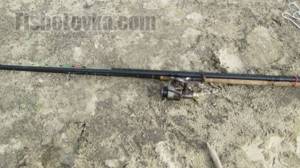
Photo 1. Budget feeder as a running donkey.
Sufficiently powerful picker rods are also suitable. With a length of 2.7 meters, the picker with the most rigid tip installed can also be used as a running bottom. The sensitivity of such forms is quite sufficient for this method of fishing. The presence of such a fishing rod allows you, if desired, to switch to classic feeder fishing (which is sometimes done when a concentration of fish is detected).
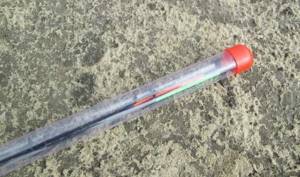
Photo 2. It is important to choose the best tip.
Often the simplest and most inexpensive gear, such as Chinese telescopic spinning rods, is used. These rods are compact, however, both sensitivity and reliability leave much to be desired. Therefore, most anglers prefer budget graphite spinning rods with a plug design.
Bottom devices
There is a bottom fishing rod - a zakidushka, it is used in rivers and large lakes. It is thrown into the right place and stays there. This device is good to use when hunting a flock. Everything needs to be assembled with high quality. A special device on the surface will indicate the bite.
To create take:
- spinning rod;
- coil;
- fishing line of at least one hundred meters, thickness 0.35 mm;
- sinker for large fish;
- hooks
Another type is a donka from a spinning rod. A big plus and application due to the convenience of fishing. There is also another name - Feeder.
If you want to get a decent trophy from the water, then this is the best option. Given the variety of fishing arsenal, you can make such a device yourself.
What you will need for assembly:
- Rod.
- High quality fishing line.
- Coil.
- Feeder.
- Hooks for large fish.
Attention is paid to the feeder. It is required so that the casting is accurate and any fish can be lured. Fishing with a feeder occurs using a “Spring”, a well-known feeder. “Cage” – similar to the first option, used in any body of water.
To create such gear, you do not need to purchase a lot of additional equipment, the most important thing is a feeder. The remaining components are always available to the fish hunter.
Let's sum it up
Fishermen are constantly improving their craft. For this purpose, devices with different configurations and equipped fishing rods are used. It can be noted that Feeder is the best way to fish with a donka rod. To achieve the best result, you will need several components: a pond, a feeder, a place to rest.
The bulk of all fishermen switch to this method of fishing: there is no need to sit for a long time and watch the float. At the same time, donka undergoes changes in equipment and fishing method over time. It is believed that this applies more to fishing from a boat; everyone chooses their own technique. An angler with such a fishing rod does not get tired, fishing brings positive emotions and pleasure, and can be used in any weather.
When going fishing, you need to have several fishing rods with you, because the hunt takes on different directions and losses are inevitable. Predators with strength, they break the rod and rip off the hooks, take away the bait - all this is required in the assortment.
Coils used
There are no mandatory requirements for reels in this fishing method. Even old inertial models can be used. They require a certain amount of experience and skill, however, the simplicity and reliability of the design, as well as the fact that most fishermen have old inertia feeders, lead to the fact that they are still used for running donks.
However, inertia-free ones are still the most popular. You can quite successfully use almost any such reel, with a standard size from 2000 to 4000. Inertialess reels are great for beginners, they are easy to learn, rarely tangle the line (often only the cheapest options let out beards) and are in the arsenal of novice fishermen, both those interested in spinning and and feeder fishing.
Unlike a classic feeder, in this bottom fishing it is quite possible to use multiplier reels, since there is no need to fix the fishing distance. This is more a rarity than a common practice, but sometimes people fish this way, because “mult” allows you to use thick fishing lines without discomfort, which is not possible on all inertia-free fishing rods, and also allows you to successfully fight the largest and most active trophies, and strong fish in the current not that uncommon.
Equipment Features
The equipment of the chassis itself is quite simple. The tackle consists of a sinker and several leashes with hooks. To make the leashes less tangled, they are attached to the main line using swivels, or anti-twist tubes are used. The load may be positioned differently. Most often, it is simply tied to the end of the main line, but there are options for attaching the sinker to a separate leash, or tying it in front of the leashes. Each of the designs has its own advantages and disadvantages.
To avoid overlapping of the leashes, the distance between them should be twice their length. So, if leashes 10 centimeters long are used, the recommended interval will be more than 20 centimeters. In the same way, you need to maintain the distance to the outlet with the coil.
Important! The passability of the equipment can be increased if you use not an ordinary sinker, but, for example, a Tyrolean stick.
As a leader material, a slightly thinner fishing line is generally used than the main one. Fluorocarbon is occasionally used, and in places where there are a lot of pike (especially if there is live bait on the hook instead of a worm), steel wire leashes can also be used.
The main line is often set quite thick, from 0.3 to 0.4 millimeters, since in such a case the current will put more pressure on the equipment and will have a positive effect on the performance of the bait. Also, the large diameter allows you to pull out the tackle when snagged, and also provides the ability to fight large fish.
Sinkers are used in pear-shaped, flat, or so-called Tyrolean sticks - this way, maximum maneuverability on a rocky or snagged bottom is achieved. On reservoirs with weak or no current, you can also use a spring weight filled with viscous bait.
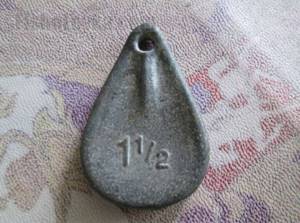
Photo 3. Flat sinker of suitable weight.
Fishing technique
For fishing in the current, use a bottom with a rubber shock absorber (elastic band), or a bottom tackle on a fishing line with several leashes located next to the bait. The technique for catching river fish, as well as equipment, is selected depending on:
- current forces;
- type of equipment;
- nozzles used;
- fishing distances.
In strong currents, it is more convenient to use a donkey with a fishing line, since the rubber shock absorber stretches under water pressure, and the equipment with hooks does not always land exactly in the fishing spot. With medium and low currents in a reservoir, a rubber bottom is more effective, it has more hooks (5-10) and it is easier to handle the tackle.
The line bottom for fishing in strong currents is equipped with a heavy sinker, and a powerful rod is selected for comfortable long-distance casting. Fishing for large fish is difficult due to the current, so you need to actively work with the reel clutch, loosening the line in time. To feed the point, a heavy mixture of groundbait and clay from the pond is made. When fishing at a short distance, feed with balls by hand or:
- from a boat;
- balls from a slingshot;
- cobra boilies.
Baits used
Not all baits are suitable for this method of fishing. Too soft options, such as, for example, semolina or bread, will quickly fly off the hook even if fishing takes place in still water. In this regard, the following baits and attachments are mainly used:
- red dung worm;
- maggot;
- live bait;
- pasta;
- pearl barley.
Important! To prevent the red dung worm from slipping off the hook, it can be secured with maggots. Among other things, such a “sandwich” often works better than maggots or worms individually.
But bait is usually not used. After all, the equipment does not remain in one place, and the current is not conducive to the use of bait mixtures - anyway, in such conditions they are ineffective, since the food is either washed away by the current, or the hooks with bait leave the feeding point during the retrieve.

